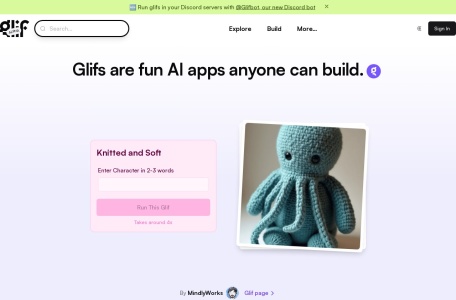
What is Glif?
Glif is a no-code AI mini-tool building platform where users can create and run small AI generators by inputting text, images, or performing simple click operations. These generators are called “glifs”. The core advantage of this platform lies in its ease of use. Even users without a programming background can quickly get started and easily build and test AI models (such as AI meme generation). Glif provides a friendly environment for non-technical users to explore and implement AI applications, lowering the technical threshold and expanding the popularization and application scope of AI technology.
The Functional Features of Glif
- User-Friendly Interface: Glif offers an intuitive drag-and-drop interface that enables users to easily build AI workflows without the need for professional programming knowledge.
- Diverse Input Support: The platform supports multiple input methods, including text, images, and click operations, to accommodate different AI application scenarios.
- Custom AI Generators: Users can create customized “glifs”, which are miniature AI generators capable of generating outputs based on user-defined rules.
- Rapid Prototyping: Glif supports rapid prototyping. Users can quickly build AI models and conduct testing and optimization.
- Model Iteration and Testing: Users can continuously iterate and test their AI generators to improve the accuracy and efficiency of the models.
- Community and Sharing: Glif has an active community where users can share their “glifs”, receive feedback, and collaborate with other users.
How to Use Glif
- Registration and Login: Visit the official Glif website (glif.app) and click on “Sign In” to register/login.
- Start Building: Click on “Build” in the top navigation bar of the website to start creating your Glif.
- Naming and Description: Set a unique title and description for your Glif. Using the hash symbol (#) in the description can convert it into a link to the corresponding tag page.
- Adding Blocks: Click on the large “+” symbol in the Glif Builder to add the first building block. Building blocks can be user inputs, prompts, tools, or styles, which work together to affect the final Glif output. There are different types of building blocks available in the builder, including pageInputs, pageGenerators, pageTools, pageStyling, and pageAdvanced/Experimental.
- Testing and Iteration: Use the testing area on the right side of the builder to test your Glif. Enter values in the input fields (if applicable) and then click “Glif it!” to view the results. Make adjustments and optimizations based on the results.
- Adding More Blocks: If you need more functionality or effects, you can continue to click on the “+” symbol to add new building blocks.
- Publish Your Glif: When you are satisfied with the output of your Glif, click on the “Publish” button at the top of the page to publish your work. All Glifs are public by default and will be visible in your profile.
The product prices of Glif
Glif is currently available for free to users, with a limit on the number of runs generated by users. Currently, each user can run it for free 200 times per day. More paid plans may be introduced in the future.
Similar Sites


MindShow

Noty.ai

Coda AI

Sheet+

PandaGPT

Formula bot

Hoarder

